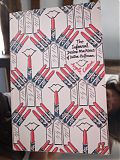
Angela Carter
The Infernal Desire Machines of Doctor Hoffman
Even before I had finished The Wind-Up Bird Chronicle by Haruki Murakami I knew what book on my shelf would follow. Not only did Angela Carter write The Infernal Desire Machines of Doctor Hoffman in Murakami’s native Japan, but Carter’s use of surrealism rivals and surpasses that of the living writer. I’ve never read a book like Hoffman though at times I was partially reminded of Cendrars’ Moravagine for its visions of viciousness. Angela Carter could clearly see the underbellies of our facades.
But the real brilliance of this book is the limits of writing Carter dissolved. In Ali Smith’s introduction, Carter is quoted as saying:
Autobiographically, what happened next, when I realized that there were no limitations to what one could do in fiction, was… I stopped being able to make a living.
The novel itself functions like the reality-bending it strives to describe. The unnamed South American metropolis is sieged by Dr. Hoffman’s desire machines which render any desire actual. It becomes impossible to determine what is real and what is not, for even illusions are tangible. The evil and single-minded Doctor is countered by the hyper-rational Minister who has no tinge of imagination, and both are eclipsed by Desiderio, the hero, who is in love with the inscrutable Albertina, the Doctor’s daughter. Though these characters may appear familiar in archetypal outline, they too are submitted to illusion and are perpetuated by the prolongation of a climax between Albertina and Desiderio.
The chapters progress in stages which Smith compares to the various sets in a single peep-show. Desiderio’s quest to kill the Doctor is quickly lost and replaced by a current of adventures that flow out into Nebulous Time (sometimes Hoffman also reminded me of Star Maker).
I felt a certain clarity and composure, for matters were quite out of our control; if we were the victims of unleashed, unknown desires, then die we must, for as long as those desires existed, we would finish by killing one another.
Hoffman is a novel of exquisite layers. On top is the surface propulsion of the story, the very compelling adventures of Desiderio through reality and formed desires. Then there is the political, social, gender aspect that is in no way dated ( Hoffman was published in 1972). There is much about women as the object of desire, under gaze or in bed, as well as heaps on power. But mostly there are the very uncanny observations that Carter makes about what lies below the surface, what desire and reality is, or is not, and how it effects us. Another part of the book which star-struck me was her veritable landslide of influences and their always appropriate cameos (and not like I could determine half her references).
In Carter’s own words:
Ocean, forest, mountain, weather—these are the inflexible institutions of that world of unquestionable reality which is so far removed from the social institutions which make up our own world that we men must always, whatever our difference, conspire to ignore them. For otherwise we would be forced to acknowledge our incomparable insignificance and the insignificance of those desires that might be the pyrotechnic tigers of our world and yet, under the cold moon and the frigid round dance of the unspeakably alien planets, are nothing but toy animals cut from coloured paper.
Commentary for The Infernal Desire Machines of Doctor Hoffman
· · · · · · · · · · · · · · · · · · · ·
1 On Wednesday 07 September 2011 Simon Griffee wrote:
Love the picture babe!!